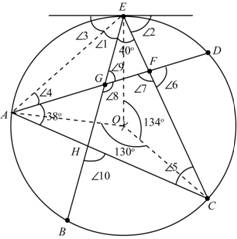
The measure of angle
The measure of angle
The measure of angle
The measure of angle
The measure of angle
The measure of angle
The measure of angle
The measure of angle
The measure of angle
The measure of angle
Answer to Problem 23AR
The measure of angle
The measure of angle
The measure of angle
The measure of angle
The measure of angle
The measure of angle
The measure of angle
The measure of angle
The measure of angle
The measure of angle
Explanation of Solution
Given information:
The angle
The given figure is as shown below.

Figure -(1)
Write the expression for angle
Write the expression for the angle
Write the expression for angle
Write the expression for angle
Write the expression for the angle sum property of a triangle
Here, the first angle of the triangle is
Write the expression for angle
Write the expression for angle
Write the expression for angle
Write the expression for angle
Write the expression for angle
Write the expression for the angle sum property of a line.
Here, the respective angles on the lines are
Calculation:
Substitute
Substitute
Substitute
Substitute
Substitute
Substitute
Substitute
Substitute
Substitute
Substitute
Substitute
Substitute
Substitute
Conclusion:
The measure of angle
The measure of angle
The measure of angle
The measure of angle
The measure of angle
The measure of angle
The measure of angle
The measure of angle
The measure of angle
The measure of angle
Want to see more full solutions like this?
Chapter 56 Solutions
Mathematics for Machine Technology
- 5.17 An aluminum curtain wall panel 12 feet high is attached to large concrete columns (top and bottom) when the temperature is 65°F. No provision is made for differen- tial thermal movement vertically. Because of insulation between them, the sun heats up the wall panel to 120°F but the column to only 80°F. Determine the consequent compressive stress in the curtain wall. CONCRETE COLUMNS CONNECTIONS Stress= ALUMINUM WALL PANEL 12'-0"arrow_forward6.2 יך 4" 2" 2" Find the centroid of the following cross-sections and planes. X= Y=arrow_forwardFind the directional derivative of the function at P in direction Varrow_forward
- 6.4 49 Find the centroid of the following cross-sections and planes. X=_ Y= C15 XAO (CENTERED) KW14x90arrow_forward5.18 The steel rails of a continuous, straight railroad track are each 60 feet long and are laid with spaces be- tween their ends of 0.25 inch at 70°F. a. At what temperature will the rails touch end to end? b. What compressive stress will be produced in the rails if the temperature rises to 150°F? T= Stress= L= 60' 25 @T=70°Farrow_forwardStrength of Materials Problems 5.16 A long concrete bearing wall has vertical expansion joints placed every 40 feet. Determine the required width of the gap in a joint if it is wide open at 20°F and just barely closed at 80°F. Assume α = 6 × 10-6/°F. Width= CONCRETE BEARING WALL EXPANSION JOINT 40' 40' 40' 293arrow_forward
- Can you show me a step by step explanation please.arrow_forward9.7 Given the equations 0.5x₁-x2=-9.5 1.02x₁ - 2x2 = -18.8 (a) Solve graphically. (b) Compute the determinant. (c) On the basis of (a) and (b), what would you expect regarding the system's condition? (d) Solve by the elimination of unknowns. (e) Solve again, but with a modified slightly to 0.52. Interpret your results.arrow_forward12.42 The steady-state distribution of temperature on a heated plate can be modeled by the Laplace equation, 0= FT T + 200°C 25°C 25°C T22 0°C T₁ T21 200°C FIGURE P12.42 75°C 75°C 00°C If the plate is represented by a series of nodes (Fig. P12.42), cen- tered finite-divided differences can be substituted for the second derivatives, which results in a system of linear algebraic equations. Use the Gauss-Seidel method to solve for the temperatures of the nodes in Fig. P12.42.arrow_forward
- 9.22 Develop, debug, and test a program in either a high-level language or a macro language of your choice to solve a system of equations with Gauss-Jordan elimination without partial pivoting. Base the program on the pseudocode from Fig. 9.10. Test the program using the same system as in Prob. 9.18. Compute the total number of flops in your algorithm to verify Eq. 9.37. FIGURE 9.10 Pseudocode to implement the Gauss-Jordan algorithm with- out partial pivoting. SUB GaussJordan(aug, m, n, x) DOFOR k = 1, m d = aug(k, k) DOFOR j = 1, n aug(k, j) = aug(k, j)/d END DO DOFOR 1 = 1, m IF 1 % K THEN d = aug(i, k) DOFOR j = k, n aug(1, j) END DO aug(1, j) - d*aug(k, j) END IF END DO END DO DOFOR k = 1, m x(k) = aug(k, n) END DO END GaussJordanarrow_forward11.9 Recall from Prob. 10.8, that the following system of equations is designed to determine concentrations (the e's in g/m³) in a series of coupled reactors as a function of amount of mass input to each reactor (the right-hand sides are in g/day): 15c3cc33300 -3c18c26c3 = 1200 -4c₁₂+12c3 = 2400 Solve this problem with the Gauss-Seidel method to & = 5%.arrow_forward9.8 Given the equations 10x+2x2-x3 = 27 -3x-6x2+2x3 = -61.5 x1 + x2 + 5x3 = -21.5 (a) Solve by naive Gauss elimination. Show all steps of the compu- tation. (b) Substitute your results into the original equations to check your answers.arrow_forward
 Trigonometry (MindTap Course List)TrigonometryISBN:9781305652224Author:Charles P. McKeague, Mark D. TurnerPublisher:Cengage Learning
Trigonometry (MindTap Course List)TrigonometryISBN:9781305652224Author:Charles P. McKeague, Mark D. TurnerPublisher:Cengage Learning Mathematics For Machine TechnologyAdvanced MathISBN:9781337798310Author:Peterson, John.Publisher:Cengage Learning,
Mathematics For Machine TechnologyAdvanced MathISBN:9781337798310Author:Peterson, John.Publisher:Cengage Learning, Holt Mcdougal Larson Pre-algebra: Student Edition...AlgebraISBN:9780547587776Author:HOLT MCDOUGALPublisher:HOLT MCDOUGAL
Holt Mcdougal Larson Pre-algebra: Student Edition...AlgebraISBN:9780547587776Author:HOLT MCDOUGALPublisher:HOLT MCDOUGAL Trigonometry (MindTap Course List)TrigonometryISBN:9781337278461Author:Ron LarsonPublisher:Cengage Learning
Trigonometry (MindTap Course List)TrigonometryISBN:9781337278461Author:Ron LarsonPublisher:Cengage Learning Elementary Geometry For College Students, 7eGeometryISBN:9781337614085Author:Alexander, Daniel C.; Koeberlein, Geralyn M.Publisher:Cengage,
Elementary Geometry For College Students, 7eGeometryISBN:9781337614085Author:Alexander, Daniel C.; Koeberlein, Geralyn M.Publisher:Cengage,




